last modified: Sunday, 13-Mar-2022 12:32:43 CET
Document status: complete
Flint and chert are dense, cryptocrystalline varieties of quartz, slightly translucent to almost opaque. Firestone, Hornstone, and Silex are other names for flint and chert. Some authors use "chert" as the more general term, with flint being a dark variant. Others use the term "flint" for nodules and "chert" for large bodies of rocks. Both terms are more often used very broadly. There's apparently no clearly defined line that separates flint from chert and that people agree on.
Note on classifying flint and chert
This chapter is called "Flint and Chert", but after looking at the matter again and again, I'm getting less and less convinced that chert and flint should be treated together in a chapter, although some authorities on that matter (e.g. Knauth, 1994) refer to flint as "nodular chert".
As a general rule, one should primarily categorize rocks according to what they are, and not to how they formed. Otherwise the nomenclature will turn quickly into a inconsistent mess, once old assumptions about the formation must be revised. In that sense, Knauth did the right thing to call flint "nodular chert", because he considers them equal in their basic physical properties.
However, I will use the term "flint" for the nodular forms and the term "chert" for the rock-forming type. This is done not so much out of respect for the "tradition", but because I'm not sure how "special" flint is in its properties, and how broadly the term chert is defined with respect to structural and physical properties.
It is possible that once I've been working through the literature more deeply I change my mind and lump chert, flint (and possibly jasper) together.
Specific Properties
Flint does not have a specific color, but is often dark gray with shades of brown, red, or yellow, and sometimes white. Brighter or more colorful variants are sometimes called chert by some people. If a large body of rock is entirely made of dense, dull cryptocrystalline quartz, it is generally called chert, regardless of its color. Flint may show color banding, but this is not a concentric banding as seen in agate.The color can be caused by inclusions of organic compounds (black), metal sulfides (black), and various metal oxides and hydroxides (yellow, orange, brown, reddish, etc.). It is slightly translucent to almost opaque, sometimes only thin chips are translucent at the edges. On freshly broken surfaces the luster is dull, at best waxy, but because it is very hard, flint takes a good polish and assumes a glassy luster, just like agate.
Flint is not a chemically very pure quartz variety, the large amounts of impurities and its fine-grained structure can make it dull and almost opaque. Some people would say that flint and chert are technically spoken not minerals, but rocks. It is a textural variety of quartz that shares some properties with jasper. It contains considerable amounts of other silica modifications, mostly moganite (Heaney and Post, 1992), perhaps opal. Like jasper, it has a very irregular, grainy structure, whereas agates - also a cryptocrystalline quartz variant - consist of regularly intergrown tiny quartz crystals that give them a "fibrous" structure. Jasper is almost opaque and typically its colors are more intense, while flint is often a bit translucent. The size of the grains in flint is between 0.5 to 20 micrometers (Knauth, 1994).
Small cavities lined with small quartz crystals (usually less than a millimeter in size) are not uncommon in large flint nodules. The walls of the cavities are often made of gray, white or blue, translucent chalcedony.
Flint freshly removed from chalk contains a few percent of water. After a couple of years they have mostly dried out and get more brittle. Flint will crack in fire because of the water in it, sometimes so badly that small flint chips fly around.
Flint concretions from sedimentary rocks forms irregular nodules that are often surrounded by a thin white layer, sometimes called cortex. Although it has a powder-like consistence and can sometimes be partially rubbed off, it is not chalk, but quartz (you cannot dissolve it in acids).
The most interesting physical property of flint is the way it splits. Flint has a conchoidal fracture like rock crystal or glass, but its fracture surfaces are not as uneven and curved. It's easier to control the direction of the splitting, and the edges are more straight. This depends a little bit on the amount of impurities, "purer" flint behaves more like glass. Chips coming off a flint can have razor sharp edges, making it suitable as a cutting tool (it's a good idea to wear safety goggles if you work on flint).
Flint is easy to spot in a gravel pit: often it is covered by a thin white layer, and - in contrast to the other pebbles - it has an irregular shape.
The latter is due to four reasons:
- Flint is hard, and has no preferred direction of cleavage.
- Flint has a tendency to split into pieces with a curved but even surface.
- Flint has a homogeneous structure and its surface is smooth and not grainy as most rocks. It is thus much less susceptible to grinding.
- Flint is quite tough and not as brittle as crystalline quartz. Although the structure is homogeneous, it is not crystalline and stress will dissipate in the material, whereas in a crystal a stress-induced small crack will often propagate through the entire crystal and split it.
Gangue quartz - which is harder than flint - has a more uneven fracture and a more inhomogeneous structure that other rocks can more easily work on, and in the end you get a white rounded pebble.

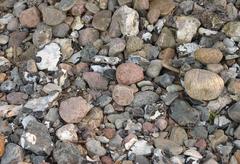
|
Below is an image of the gravel in the upper part of the beach. Roughly half of all the rocks are flint. Many of them have a white cortex, others can be recognized by their irregular shape and glass-like fracture pattern. The field of view of that image is about 80 cm.
In many pieces of flint from sedimentary rocks one can find tiny white marine fossils, embedded silica skeletons of radiolaria, foraminiferes, diatoms, or sponges. Sometimes the fossils are quite big, like the silicified sea urchins that are occasionally found in the chalk cliffs at the island of Rügen in the Baltic Sea, or the Cretaceous chalk of Dorset in southwestern England.
Microstructure

200μm 2160x1434 353kb |

200μm 2160x1434 716kb |

100μm 1024x1024 230kb |
Occurrence
Flint occurs as irregularly shaped concretions in sedimentary rocks, usually in chalk, a soft limestone, but also as fillings in cracks in other types of rock. Flint also forms thin layers between the beds of the sedimentary rocks. The platy specimen from such layers are just a few millimeters or centimeters thick.In sedimentary rocks, the silica in flint is usually of biogenic origin: countless skeletons of tiny marine organisms, like radiolaria, foraminiferes, or diatoms that have sedimented on the ocean floor and are slowly buried under more chalk, silica and organic ooze. The silica skeletons consist of opaline silica (amorphous silica with some water) and are much easier dissolved in alkaline solutions than quartz. The process that concentrates dissolved silica locally to form concretions (the flint nodules nodules) is apparently related to the decay of organic material from the dead animals under anaerobic conditions (absence of oxygen). The altered chemical composition of the surrounding watery solutions[1] causes the silica to accumulate around the dead body, and occasionally a larger fossil, like the skeleton of a sea urchin, can be found inside a flint nodule.
I don't know much about other places, but in Europe flint can be found in large quantities weathering out of the Cretaceous chalk cliffs of the Baltic Sea and the English Channel (e.g. the "Cliffs of Dover"). It forms "in situ soap deposits" where the chalk has been washed away and has been widely distributed by glaciers that moved over the Baltic Sea southward during the ice ages. When you hike in the glacially transformed landscape of Northern Germany, most of the pebbles you see are flint, the rest are pebbles of igneous and metamorphic rocks from Scandinavia. There is actually a "firestone line", the southern border of the distribution of flint which coincides roughly with the southern border of the ice shield during the last ice age.
In France, flint can be found in Cretacean limestones in the Isle de France, and it used to be mined in that area during the stone ages. Similar flint deposits are found in Jurassic limestones of the Fränkische Alb in Bavaria, Germany.
Chert as a rock-forming material is described in the chapter Quartz as a Rock-Forming Mineral.
"The Flintstones"
We know from findings in the Olduvai Gorge in Kenia (where the remains of "Lucy", a female Australopithecus, have been discovered) and many other classic locations of anthropology, that flint, along with obsidian and crystalline quartz has been used as a raw material for tools as early as 1.5 million years ago.In the neolithic age (the late stone age) flint was one of the first minerals to be mined and traded. Flint tools have been found several hundred kilometers away from the origin of the raw material. Important sources were Syria and Mesopotamia (about 6000-5000 b.c.), or France and England during the megalith age (about 4000-2000 b.c). The Grimes Graves Mines in Norfolk, England, had 360 shafts (Source: ->"Past Worlds - Times Atlas of Archeology"). The many collapsed mining shafts have turned the area into a strange looking landscape of craters that have puzzled people for centuries. In some churches in southern England you can see flint used as ornamental stone or even as a principal building material.

|
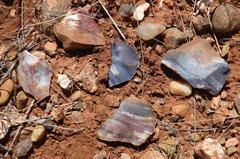
50mm 1520x1007 568kb - 3039x2014 1680kb |
Flintknapping
Some people still work on flint today as a hobby, a practice called "flintknapping". Flintknapping involves basically 2 techniques:1. striking the rock with a tool (like a hammer, rock, or wood)
2. applying pressure with a relatively soft tool (wood, bone, copper) for the fine work to chip off tiny flakes.
This is also the way the flint has been crafted into arrow heads, axes, and knives in the stone age or by American Indians in historic times. Flintknappers can work on many materials, like glass, obsidian, or agate, but good quality flint is still one of their favorites. Sometimes the flint is heat treated to make it more workable.
Firestone and Firearms
Flint was used to ignite gunpowder in firearms until the early 19th century. Flint alone will not do it, though: the flint is used to hit pyrite (FeS2), which will give of sparks, as the energy of the strike is converted into heat energy. If you hit one flint with another flint really hard, you can sometimes also see some sparks, but this is not a very reliable way of producing them. When flint hits pyrite, the heat energy will ignite tiny grains coming off the pyrite that will burn in air to form iron oxides and sulfur dioxide, SO2 (that's why it smells "like sulfur").
Locations and Specimen
Belgium

10mm 1808x1568 440kb - 3616x3136 1300kb |
Denmark
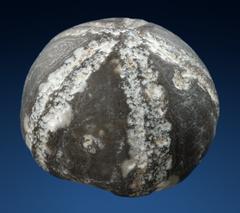
5mm 1128x1000 165kb |
Germany

20mm 950x800 76kb |
The thick white crust, the cortex, is not made of chalk, but of fine-grained opaline silica. The dense and homogeneously colored core is almost black of inclusions of organic compounds.
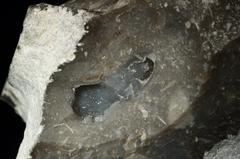
10mm 1024x678 117kb 3038x2012 748kb |
There is also one of the small cavities that can frequently be found inside flint nodules, outlined with tiny quartz crystals. The specimen is from the same location as the one on the first image.

20mm 1024x678 99kb - 3038x2012 550kb - |

20mm 1191x1003 130kb - 2382x2007 376kb |

20mm 2200x1544 243kb |
If you visit Helgoland you will notice the vertical red sandstone cliffs of Triassic age that make up most of the island. The flint is not from the cliffs but from younger Cretaceous limestones that are below the water line. Flint nodules that got detached after storms also accumulate on the beaches of the small neighboring island Düne. I've never tried it myself but I've heard that one needs to be really patient to find a red flint - the one you see on the photo is bought. More information on Helgoland flint and the location can be found at FlintSource.NET.
U.S.A.
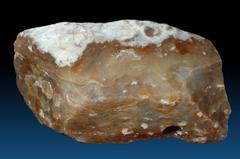
20mm 1520x1007 172kb - 3039x2014 525kb |
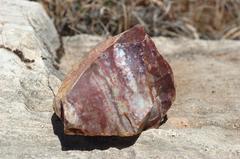
50mm 1520x1007 300kb |

50mm 1520x1007 312kb |
Further Information, Literature, Links
L.P. Knauth wrote a review article on ->the petrogenesis of chert that compares the various environmental conditions for chert and flint formation.The FlintSource.NET web site gives information on flint locations (nicely done with a clickable map), with scans and photos of specimen and localities, and descriptions of flint types.
The Flints from Portsdown Hill covers the local specialties, but also explains the general terms, the formation of flint nodules, and some of the included fossils.
If you are interested in more information about flintknapping, www.flintknapping.com might be a good starting point.
GEMROCKS: Ornamental & Curio Stones includes a list of North American locations, synonyms and a general description of chert and flint.
Footnotes
1 For example, when proteins decay, amines get released. These are alkaline organic nitrogen compounds related to ammonia that will rise the pH of the water. They are also the cause of the bad smell of old fish, by the way.
 Printer Friendly Version
Printer Friendly VersionCopyright © 2005-2022, A.C. A k h a v a n
Impressum - Source: http://www.quartzpage.de/flint.html
